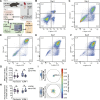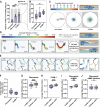T cells use focal adhesions to pull themselves through confined environments
- PMID: 38889096
- PMCID: PMC11187980
- DOI: 10.1083/jcb.202310067
T cells use focal adhesions to pull themselves through confined environments
Abstract
Immune cells are highly dynamic and able to migrate through environments with diverse biochemical and mechanical compositions. Their migration has classically been defined as amoeboid under the assumption that it is integrin independent. Here, we show that activated primary Th1 T cells require both confinement and extracellular matrix proteins to migrate efficiently. This migration is mediated through small and dynamic focal adhesions that are composed of the same proteins associated with canonical mesenchymal cell focal adhesions, such as integrins, talin, and vinculin. These focal adhesions, furthermore, localize to sites of contractile traction stresses, enabling T cells to pull themselves through confined spaces. Finally, we show that Th1 T cells preferentially follow tracks of other T cells, suggesting that these adhesions modify the extracellular matrix to provide additional environmental guidance cues. These results demonstrate not only that the boundaries between amoeboid and mesenchymal migration modes are ambiguous, but that integrin-mediated focal adhesions play a key role in T cell motility.
© 2024 Caillier et al.
Conflict of interest statement
Disclosures: All authors have completed and submitted the ICMJE Form for Disclosure of Potential Conflicts of Interest. P.W. Oakes reported grants from NIAID—P01-AI102851 during the conduct of the study. No other disclosures were reported.
Figures









Update of
-
T cells Use Focal Adhesions to Pull Themselves Through Confined Environments.bioRxiv [Preprint]. 2023 Oct 19:2023.10.16.562587. doi: 10.1101/2023.10.16.562587. bioRxiv. 2023. Update in: J Cell Biol. 2024 Oct 7;223(10):e202310067. doi: 10.1083/jcb.202310067. PMID: 37904911 Free PMC article. Updated. Preprint.
References
-
- Adebowale, K., Ha B., Saraswathibhatla A., Indana D., Popescu M.C., Demirdjian S., Yang J., Bassik M.C., Franck C., Bollyky P.L., and Chaudhuri O.. 2023. Monocytes use protrusive forces to generate migration paths in viscoelastic collagen-based extracellular matrices. bioRxiv. 10.1101/2023.06.09.544394 (Preprint posted June 11, 2023). - DOI
-
- Allan, D.B., Caswell T., Keim N.C., van der Wel C.M., and Verweij R.W.. 2023. Soft-matter/trackpy: v0.6.1. Zenodo. 10.5281/zenodo.7670439 - DOI
MeSH terms
Substances
Grants and funding
LinkOut - more resources
Full Text Sources

